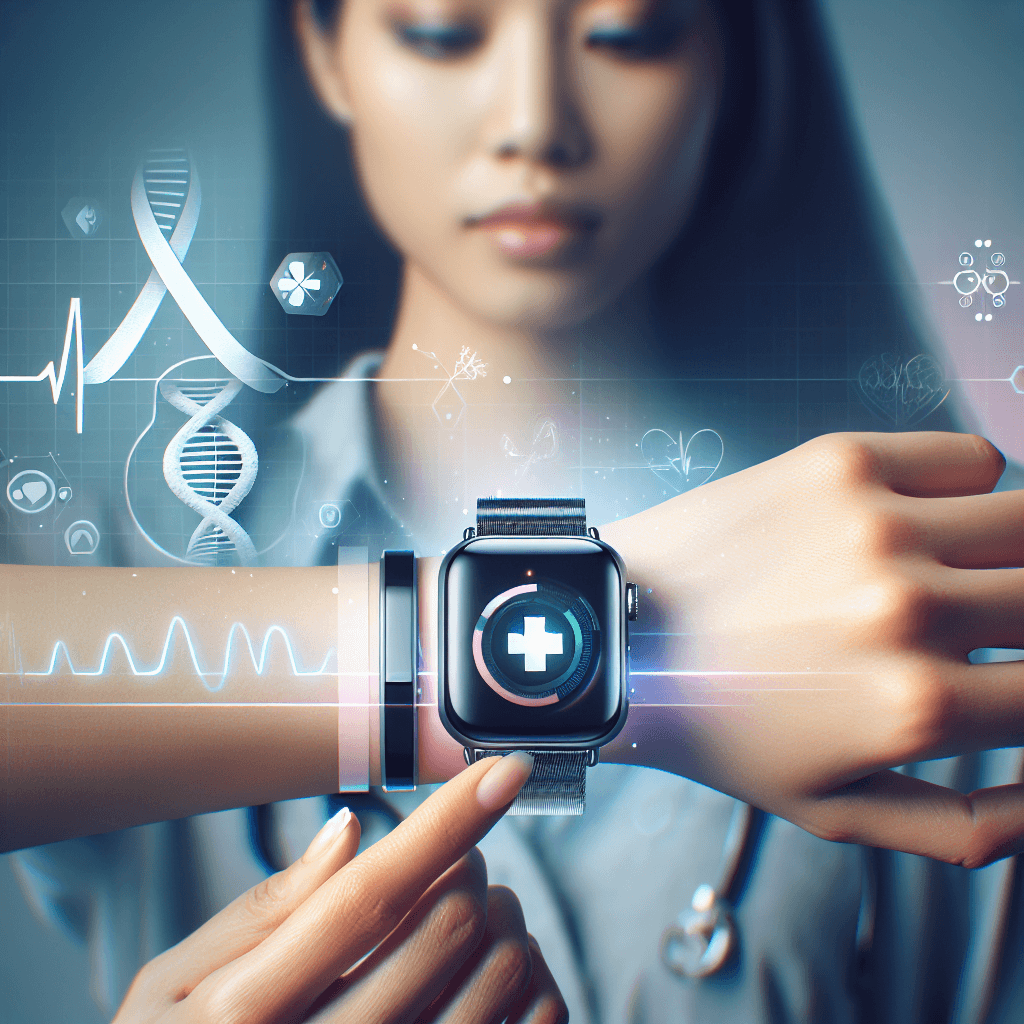In the world of healthcare, technology continues to revolutionize the way we manage our well-being. As we approach 2024, the emergence of digital health trends promises to reshape the way we access and receive medical care. With advancements in artificial intelligence, telehealth, wearable devices, and data analytics, the future of healthcare appears to be increasingly personalized, efficient, and patient-centric. This article explores some of the key emerging trends in digital health that are set to make a significant impact in the coming years.
Table of Contents
Telemedicine and Virtual Care
Remote consultation
In the rapidly evolving field of digital health, telemedicine and virtual care have emerged as game-changers. With remote consultation, patients can now connect with healthcare providers without leaving the comfort of their homes. This allows for convenient and timely access to medical care, especially for those who may have difficulty traveling to a traditional clinic or hospital setting. Through video calls, phone calls, and even secure messaging platforms, patients can communicate with doctors, nurse practitioners, and other healthcare professionals to discuss their symptoms, receive diagnoses, and even be prescribed medication if necessary. Remote consultation has the potential to revolutionize the way healthcare is delivered, ensuring that patients can receive timely medical advice without the need for in-person visits.
Virtual monitoring
Another aspect of telemedicine is virtual monitoring, which enables healthcare providers to remotely monitor patients’ vital signs and health data. With the help of wearable devices and connected medical tools, patients can transmit real-time data, such as heart rate, blood pressure, glucose levels, and sleep patterns, to their healthcare providers. This allows for continuous monitoring of chronic conditions, early detection of potential health issues, and personalized treatment adjustments. Virtual monitoring not only reduces the need for frequent visits to healthcare facilities but also empowers patients to actively engage in managing their own health. By providing healthcare professionals with a comprehensive picture of a patient’s health status, virtual monitoring can lead to more accurate diagnoses, more informed treatment decisions, and ultimately better health outcomes.
Telehealth platforms
Telehealth platforms are a central component of telemedicine and virtual care. These platforms serve as a bridge between patients and healthcare providers, facilitating secure communication, data exchange, and access to medical services. They offer various features, such as appointment scheduling, electronic health records (EHR) integration, and prescription management. Telehealth platforms can also support video consultations, allowing healthcare professionals to visually assess patients’ conditions, further enhancing the remote consultation experience. With the advancement of telehealth platforms, healthcare providers can deliver high-quality care efficiently, while patients can conveniently access healthcare services and engage in their own care journey.
Artificial Intelligence and Machine Learning
Clinical decision support systems
Artificial intelligence (AI) and machine learning (ML) technologies are reshaping the landscape of healthcare by offering sophisticated clinical decision support systems. These systems leverage algorithms to analyze vast amounts of medical data, including patient records, medical literature, and treatment guidelines. By sifting through this data, AI-powered clinical decision support systems can provide healthcare professionals with evidence-based recommendations, helping them make more accurate diagnoses and formulate optimal treatment plans. These systems can also assist in identifying potential drug interactions, predicting disease progression, and flagging abnormal test results. The integration of AI and ML into clinical workflows has the potential to enhance patient safety, reduce diagnostic errors, and improve overall healthcare outcomes.
Predictive analytics
Predictive analytics is a powerful application of AI and ML in healthcare. By analyzing historical data, such as electronic health records, genomics data, and social determinants of health, predictive analytics algorithms can identify patterns and predict future health events. This enables healthcare providers to proactively intervene and take preventive measures, reducing the likelihood of adverse health outcomes. For example, predictive analytics can identify patients at high risk of developing chronic conditions, allowing healthcare teams to initiate early interventions and develop personalized care plans. Furthermore, predictive analytics can help optimize resource allocation and improve population health management by identifying trends and patterns in large datasets. As healthcare systems continue to generate vast amounts of data, the use of predictive analytics will become increasingly valuable in improving patient care and outcomes.
Medical imaging analysis
The field of medical imaging has also benefited greatly from AI and ML advances. Medical image analysis, which includes tasks such as image interpretation, segmentation, and detection, can be significantly augmented by AI techniques. AI-powered algorithms can analyze medical images, such as X-rays, CT scans, and MRIs, to assist radiologists and other healthcare professionals in detecting abnormalities and providing diagnostic insights. These algorithms can flag suspicious areas that may require further scrutiny, helping radiologists prioritize their review and potentially reducing diagnostic errors. Additionally, AI can aid in the development of computer-aided diagnosis systems, which can serve as a second opinion or assist in challenging cases. The integration of AI and ML in medical imaging analysis has the potential to enhance the accuracy and efficiency of diagnoses, enabling earlier detection of diseases and potentially saving lives.

Internet of Medical Things
Wearable devices
The Internet of Medical Things (IoMT) refers to the network of medical devices and wearables that are connected to the internet, enabling remote monitoring and data collection. Wearable devices, such as smartwatches, fitness trackers, and continuous glucose monitors, have gained popularity in recent years. These devices can collect real-time data on various health parameters, such as heart rate, steps taken, sleep patterns, and blood glucose levels. By transmitting this data to healthcare providers, wearable devices can contribute to a more comprehensive and continuous understanding of patients’ health status. This real-time data can help healthcare teams detect early signs of health issues, monitor chronic conditions, and provide personalized interventions. Wearable devices empower individuals to actively manage their health and make informed lifestyle choices, promoting preventive care and overall well-being.
Connected medical devices
Beyond wearables, the IoMT encompasses a wide range of connected medical devices used in clinical settings. These devices include smart infusion pumps, remote patient monitoring systems, and connected vital signs monitors. Connected medical devices enable healthcare professionals to remotely monitor patients and gather data on vital signs, medication adherence, and treatment effectiveness. By securely transmitting data to healthcare providers, these devices enable timely interventions and personalized treatment adjustments. Connected medical devices not only improve patient care and safety but also enhance workflow efficiencies for healthcare professionals. With the ability to continuously monitor patients, healthcare providers can proactively identify and address potential issues, leading to better outcomes and reduced hospital readmissions.
Remote patient monitoring
Remote patient monitoring (RPM) is a key application of the IoMT that allows healthcare providers to monitor patients’ health status from a distance. RPM involves the use of connected medical devices and wearables to collect and transmit patient data to healthcare teams. This data can include vital signs, medication adherence, symptoms, and lifestyle behaviors. By remotely monitoring patients, healthcare providers can identify early signs of deterioration, adjust treatment plans, and intervene promptly when necessary. RPM is particularly valuable for managing chronic conditions, such as diabetes, hypertension, and heart disease, as it enables proactive care and early intervention. By reducing the need for in-person visits, RPM not only improves patient convenience and quality of life but also optimizes healthcare resource utilization.
Big Data and Analytics
Healthcare data management
The increasing digitalization of healthcare has led to the generation of vast amounts of data, often referred to as big data. Effectively managing and analyzing this data is crucial for deriving meaningful insights and improving patient care. Healthcare data management involves the storage, integration, and analysis of diverse datasets, including electronic health records, sensor data, genomics data, and population health data. Advanced data management systems and technologies are required to handle the volume, velocity, and variety of healthcare data. Data governance frameworks, data warehouses, and data lakes are used to ensure data quality, interoperability, and accessibility. Effective healthcare data management enables healthcare providers to make evidence-based decisions, develop personalized treatment plans, and improve population health management.
Predictive modeling
Predictive modeling leverages big data and analytics to forecast future health events and outcomes. By analyzing historical data, patterns, and trends, predictive modeling algorithms can identify risk factors and predict the likelihood of specific health events, such as disease onset, hospitalization, or readmission. Predictive modeling can help healthcare providers allocate resources effectively, develop preventive strategies, and deliver personalized care. For example, predictive models can identify high-risk patients who may benefit from targeted interventions, such as care management programs or early referrals to specialists. Moreover, predictive modeling can enable proactive monitoring and timely interventions, reducing healthcare costs and improving patient outcomes. As healthcare systems continue to generate vast amounts of data, predictive modeling will play an increasingly critical role in shaping healthcare delivery and improving patient outcomes.
Real-time analytics
Real-time analytics is a powerful tool that enables healthcare providers to leverage data insights at the point of care. By analyzing data in real-time, healthcare professionals can make informed and timely decisions, improving patient safety and outcomes. Real-time analytics can help identify anomalies, detect potential adverse events, and provide decision support at critical moments. For example, real-time analytics can alert healthcare teams to abnormal vital signs or alert them to potential medication errors. Real-time analytics can also assist in streamlining workflows, optimizing resource utilization, and reducing delays in diagnosis and treatment. By integrating real-time analytics into clinical workflows, healthcare providers can deliver more efficient, precise, and personalized care.

Blockchain Technology
Health data privacy and security
Blockchain technology has the potential to revolutionize health data privacy and security. The decentralized nature of blockchain allows for the secure and transparent storage of health data, ensuring patient information is protected against unauthorized access and tampering. Health data stored on the blockchain can be encrypted and accessed only by authorized parties, providing patients with greater control over their personal health information. Blockchain can also enable patients to grant or revoke access to their data to healthcare providers, researchers, or other stakeholders, enhancing privacy and consent management. Additionally, blockchain-based systems can enable secure sharing of health data between healthcare institutions, improving care coordination and reducing duplication of tests or procedures.
Medical record management
The management of medical records is a critical aspect of healthcare delivery. Traditionally, medical records were kept in paper format, leading to challenges in accessibility, interoperability, and security. Blockchain technology can address these challenges by providing a secure and immutable record-keeping system. By leveraging blockchain, medical records can be securely stored, accessed, and shared across healthcare organizations. Patients can have a comprehensive, lifetime medical record that allows for continuity of care, even when visiting different healthcare providers. Blockchain-based medical record management systems can reduce administrative burdens, streamline data exchange, and facilitate better care coordination among healthcare providers, ultimately leading to better patient care and outcomes.
Supply chain management
Blockchain technology can also enhance supply chain management in the healthcare industry. The pharmaceutical supply chain, for example, involves multiple stakeholders, including manufacturers, distributors, and pharmacies. Errors or fraudulent activities within the supply chain can have serious consequences for patient safety. By using blockchain, the pharmaceutical supply chain can be made more transparent and secure. Each transaction or movement of medication can be recorded on the blockchain, creating an auditable and tamper-proof trail. This ensures the authenticity and integrity of medications, reduces the risk of counterfeiting or diversion, and enhances patient safety. Blockchain-based supply chain management systems can improve traceability, reduce costs, and enhance the overall efficiency and safety of healthcare supply chains.
Cloud Computing
Data storage and sharing
Cloud computing has revolutionized the storage and sharing of healthcare data. Cloud-based systems provide a scalable and cost-effective solution for storing and managing large volumes of data generated by healthcare organizations. The cloud offers secure and reliable storage, ensuring that patient data is protected against loss or unauthorized access. Moreover, cloud storage enables seamless data sharing and collaboration between healthcare providers, researchers, and other stakeholders. This facilitates interdisciplinary care, promotes research collaboration, and enhances the overall quality of healthcare delivery. Cloud-based data storage also enables real-time access to patient records, regardless of geographic location or device, enabling healthcare providers to make informed decisions promptly.
Scalability and flexibility
One of the key advantages of cloud computing is its scalability and flexibility. Healthcare organizations can easily scale their computing resources up or down based on their needs, without the need for significant infrastructure investments. This scalability allows healthcare providers to handle spikes in demand, such as during public health emergencies or seasonal healthcare demands. Cloud computing also enables the deployment of new healthcare applications and services quickly and efficiently. With the increasing adoption of digital health solutions, healthcare organizations can rely on cloud infrastructure to accommodate the growing demand for data storage, processing power, and connectivity. Cloud-based solutions provide the agility and scalability needed to adapt to a fast-paced and ever-changing healthcare environment.
Remote access to patient records
Cloud computing enables remote access to patient records, offering healthcare providers greater flexibility and mobility. With cloud-based electronic health record (EHR) systems, clinicians can access patient information securely from anywhere, using various devices. This remote access eliminates the need for physical copies of patient records, reducing the risk of lost or misplaced files. Moreover, cloud-based EHR systems allow for real-time updates and synchronization, ensuring that healthcare professionals have access to the most up-to-date patient information. Remote access to patient records enhances care coordination, improves communication between healthcare teams, and enables prompt decision-making, ultimately enhancing the quality and continuity of care.

Genomics and Precision Medicine
Personalized treatment plans
Genomics and precision medicine have the potential to revolutionize healthcare by tailoring treatments to an individual’s unique genetic makeup. Genomics involves the study of an individual’s genes and their interaction with environmental factors. By analyzing an individual’s genetic information, healthcare teams can gain insights into their predisposition to certain diseases, prediction of treatment response, and potential adverse drug reactions. This information can inform the development of personalized treatment plans that are tailored to each patient’s specific genetic profile. Personalized treatment plans can optimize therapeutic efficacy, reduce the risk of adverse events, and improve patient outcomes.
Targeted therapies
Targeted therapies are a prime example of how genomics and precision medicine can transform treatment approaches. Molecular profiling and genomic sequencing can identify specific genetic alterations or mutations that drive the growth of certain cancers or other diseases. By targeting these genetic alterations, targeted therapies can inhibit the growth of cancer cells while sparing healthy cells, leading to more effective and less toxic treatments. Targeted therapies have shown promising results in various forms of cancer, including melanoma, lung cancer, and leukemia. Genomics-based targeted therapies offer new hope for patients with previously untreatable or difficult-to-treat diseases, potentially improving survival rates and quality of life.
Genetic testing
Genetic testing is becoming increasingly accessible and plays a vital role in genomics and precision medicine. Genetic tests can identify genetic variations or mutations that may increase the risk of developing certain diseases or influence an individual’s response to medications. For example, genetic testing can identify gene variants associated with an increased risk of hereditary cancer syndromes, such as BRCA1 and BRCA2 mutations in breast and ovarian cancer. This information can guide healthcare providers in developing personalized screening strategies, preventive measures, and targeted interventions. Genetic testing can also assist in pharmacogenomic testing, which determines how an individual’s genes may affect their response to specific medications. By integrating genetic testing into clinical practice, healthcare providers can offer more personalized and evidence-based care, improving patient outcomes and quality of life.
Virtual Reality and Augmented Reality
Surgical simulations
Virtual reality (VR) and augmented reality (AR) technologies are revolutionizing surgical training and education. Surgical simulations using VR and AR can provide a safe and immersive environment for surgeons to practice complex procedures and hone their skills. Surgeons can perform virtual surgeries, gaining hands-on experience and learning from mistakes without jeopardizing patient safety. VR and AR can simulate realistic surgical scenarios and provide haptic feedback, enhancing the realism of the training experience. These technologies can also enable remote learning and collaboration, allowing surgeons to engage in virtual consultations and receive guidance from expert surgeons around the world. Surgical simulations using VR and AR have the potential to improve surgical outcomes, reduce complications, and standardize surgical training.
Pain management
VR and AR technologies are being increasingly used in pain management. These immersive technologies can distract patients from pain and provide a more enjoyable and engaging experience during medical procedures or physical therapy sessions. By creating virtual environments, such as peaceful landscapes or interactive games, VR and AR can help reduce the perception of pain and anxiety. For example, VR has been used successfully to manage pain during burn wound care, dental procedures, and childbirth. Additionally, AR can be used to provide real-time guidance and feedback during physical therapy sessions, improving adherence to exercises and enhancing rehabilitation outcomes. VR and AR have the potential to transform pain management by offering non-pharmacological alternatives and improving the overall patient experience.
Physical therapy
Virtual reality and augmented reality have immense potential in the field of physical therapy. These technologies can offer interactive and engaging rehabilitation exercises that motivate patients and promote active participation in their own recovery. For individuals with mobility limitations, VR and AR can create virtual environments that simulate various activities, such as walking or climbing stairs, allowing patients to practice and regain functional abilities. The immersive nature of these technologies can also enhance the mind-body connection, promoting motor learning and neuroplasticity. Additionally, VR and AR can provide real-time feedback and performance metrics, helping physical therapists monitor progress and tailor treatment plans. By integrating VR and AR into physical therapy, healthcare providers can improve therapy outcomes, enhance patient engagement, and accelerate the rehabilitation process.

Patient Engagement
Mobile health applications
Mobile health applications, commonly known as mHealth apps, are empowering patients to take an active role in managing their health. These applications run on smartphones and other mobile devices, offering a range of features and functionalities. Patients can use mHealth apps to track their physical activity, monitor vital signs, manage medications, and receive personalized health information. These apps can also provide reminders, alerts, and educational content, fostering healthy behaviors and self-care. Moreover, mHealth apps can enable patients to securely communicate with healthcare providers, schedule appointments, and access lab results or medical records. By facilitating continuous engagement and communication, mHealth apps enhance patient empowerment, improve health outcomes, and promote preventive care.
Health tracking and monitoring
The rise of wearables and connected devices has paved the way for health tracking and monitoring. Patients can now monitor various health parameters, such as heart rate, sleep patterns, activity levels, and blood glucose, using devices such as smartwatches, fitness trackers, and continuous glucose monitors. These devices provide real-time data that can be synced with mobile apps or cloud-based platforms. Health tracking and monitoring allow patients to gain insights into their health status, track progress towards health goals, and identify potential health issues. By visualizing their health data, patients can make informed decisions, adjust lifestyle behaviors, and actively participate in their own care. Health tracking and monitoring can empower patients to take charge of their health and well-being, fostering a proactive approach to healthcare.
Personalized health education
Personalized health education is a key component of patient engagement. By tailoring health information to individuals’ specific needs, preferences, and health goals, healthcare providers can effectively educate and empower patients to make informed decisions regarding their health. Personalized health education may include targeted messages, educational materials, and resources that address patients’ specific health conditions, risk factors, or lifestyle behaviors. This information can be delivered through various channels, including websites, mobile apps, email, or text messages. Personalized health education fosters patient understanding, enhances health literacy, and promotes adherence to treatment plans or healthy behaviors. By supporting patients with tailored information, healthcare providers can improve patient outcomes and satisfaction, while also optimizing healthcare resource utilization.
Cybersecurity and Data Privacy
Protection against data breaches
With the increasing digitization of healthcare, ensuring cybersecurity and data privacy has become paramount. Healthcare organizations store vast amounts of sensitive patient data, including medical records, personal information, and payment details. Protecting this data from unauthorized access, breaches, or cyber threats is essential to maintain patient trust and secure the integrity of the healthcare system. Healthcare organizations must implement robust cybersecurity measures, including encryption, firewalls, intrusion detection systems, and employee training on data security best practices. Regular vulnerability assessments and proactive monitoring of IT systems are also crucial to identify and address potential security risks. By investing in robust cybersecurity measures, healthcare organizations can safeguard patient data and maintain the confidentiality and integrity of healthcare systems.
Ensuring patient privacy
Patient privacy is a fundamental aspect of healthcare provision. With the increasing digitization of health records and the sharing of health data across systems, ensuring patient privacy has become more challenging and critical than ever. Healthcare organizations must comply with privacy regulations, such as the Health Insurance Portability and Accountability Act (HIPAA) in the United States, to protect patient privacy and confidentiality. Encryption and access controls must be implemented to ensure that patient data is secure and accessible only to authorized individuals. Staff members must be trained on privacy policies and protocols, including the appropriate handling and disposal of personal health information. Regular audits and assessments are necessary to identify and address any privacy vulnerabilities. By prioritizing patient privacy, healthcare organizations can build trust and instill confidence in patients, contributing to improved patient engagement and satisfaction.
Security of medical devices
The increasing connectivity of medical devices brings both benefits and security risks. Medical devices, such as insulin pumps, pacemakers, and infusion pumps, are now often connected to networks, enabling data transmission, remote monitoring, and control. However, this connectivity also introduces vulnerabilities that can be exploited by cybercriminals. To ensure the security of medical devices, healthcare organizations must implement measures to protect against unauthorized access, tampering, or misuse. This includes implementing strong authentication protocols, encryption, and regular software updates. Manufacturers must also be responsible for embedding security features into their devices and ensuring timely security patches. Healthcare providers must collaborate with manufacturers, regulators, and cybersecurity experts to address potential security vulnerabilities and establish safeguards to protect patients’ safety and data integrity.
In conclusion, emerging trends in digital health have the potential to revolutionize healthcare delivery, improve patient outcomes, and enhance patient engagement. Telemedicine and virtual care offer convenient and timely access to medical services, enabling remote consultations and continuous patient monitoring. Artificial intelligence and machine learning empower healthcare providers with clinical decision support systems, predictive analytics, and advanced medical imaging analysis. The Internet of Medical Things enables remote patient monitoring and the integration of connected devices into healthcare workflows. Big data and analytics facilitate healthcare data management, predictive modeling, and real-time analytics. Blockchain technology ensures health data privacy and security, enhances medical record management, and strengthens supply chain management. Cloud computing enables data storage, scalability, flexibility, and remote access to patient records. Genomics and precision medicine revolutionize personalized treatments, targeted therapies, and genetic testing. Virtual reality and augmented reality enhance surgical simulations, pain management, and physical therapy. Patient engagement is promoted through mobile health applications, health tracking and monitoring, and personalized health education. Lastly, ensuring cybersecurity and data privacy protects against data breaches, safeguards patient privacy, and strengthens the security of medical devices. Together, these emerging trends in digital health pave the way for a more patient-centered, efficient, and secure healthcare system.


